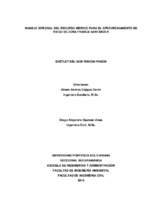| dc.contributor.advisor | Cajigas Cerón, Álvaro Andrés | |
| dc.contributor.advisor | Guzmán Arias, Diego Alejandro | |
| dc.contributor.author | Rincón Pabón, Shetley del Mar | |
| dc.coverage.temporal | 2014 | |
| dc.date.accessioned | 2022-04-20T22:14:56Z | |
| dc.date.available | 2022-04-20T22:14:56Z | |
| dc.date.issued | 2014 | |
| dc.identifier.uri | http://hdl.handle.net/20.500.11912/9958 | |
| dc.description | 108 páginas | spa |
| dc.description.abstract | El aprovechamiento del recurso hídrico para un sistema de riego en el parque empresarial
Zona Franca Santander, hacen necesaria la búsqueda de dos alternativas que permitan suplir el requerimiento de agua demandada por las zonas verdes del proyecto, sin hacer uso del agua potable. En este estudio se permitió conocer la demanda hídrica mediante el uso del método del coeficiente de jardín y se evaluó la viabilidad de hacer uso para recirculación de aguas lluvias, agua residual y la concesión de agua emitida por la CDMB, para ser usadas como abastecimiento de la oferta hídrica dentro del balance hídrico realizado. El agua residual doméstica tratada por la planta de tratamiento de lodos activados de Zona Franca Santander
cumple con los porcentajes de remoción designados por la normativa; sin embargo la PTAR no se comporta como un reactor de lodos activados, sino como un sistema tradicional, debido a que la degradación se da por oxidación más no por degradación aeróbica. Las alternativas propuestas sugieren hacer uso del agua residual domestica tratada como fuente de abastecimiento, con la implementación de un desarenador, un tanque de almacenamiento que permita la distribución a todo el sistema de riego por medio de un hidroneumático. | spa |
| dc.description.abstract | The utilization of water resources for irrigation in the Zona Franca Santander, business park necessitate the search for two alternatives to meet the requirement of water demanded by the green areas of the project, without making use of drinking water. This study allowed to meet the water demand by using the method of the coefficient of garden and the feasibility of using recirculation stormwater , wastewater and water concession issued by the CDMB was evaluated for use as supply the water supply within the water balance performed . Domestic wastewater treated by the treatment plant activated Zone sludge Franca Santander meets removal percentages designated by the regulations , but the WWTP does not behave as a
reactor of an activated sludge but as a traditional system , since degradation occurs by oxidation but not by aerobic degradation . The proposed alternatives suggest use of treated domestic wastewater as a source of supply, with the implementation of a sand trap, a storage tank to allow distribution to all irrigation system by a hydropneumatic. | eng |
| dc.format.mimetype | application/pdf | |
| dc.language.iso | spa | |
| dc.publisher | Universidad Pontificia Bolivariana | spa |
| dc.rights | Attribution-NonCommercial-NoDerivatives 4.0 International | * |
| dc.rights.uri | http://creativecommons.org/licenses/by-nc-nd/4.0/ | * |
| dc.subject | Ingeniería Ambiental | spa |
| dc.subject | Ingeniería Civil | spa |
| dc.subject | Recursos hidrológicos | spa |
| dc.subject | Aguas residuales | spa |
| dc.subject | Aguas lluvias / CDMB (Corporación Autónoma Regional para la Defensa de la Meseta de Bucaramanga) | spa |
| dc.title | Manejo integral del recurso hídrico para el aprovechamiento en riego de zona franca Santander | spa |
| dc.type | Trabajo de grado | spa |
| dc.publisher.department | Escuela de Ingenierías | spa |
| dc.publisher.program | Ingeniería Ambiental | spa |
| dc.publisher.program | Ingeniería Civil | spa |
| dc.type.hasVersion | publishedVersion | spa |
| dc.description.sectional | Bucaramanga | spa |
| dc.description.degreename | Ingeniero Ambiental | spa |
| dc.description.degreename | Ingeniero Civil | spa |


